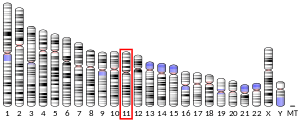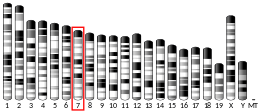TRPM5
Transient receptor potential cation channel subfamily M member 5 (TRPM5), also known as long transient receptor potential channel 5 is a protein that in humans is encoded by the TRPM5 gene.[5][6]
Function
TRPM5 is a calcium-activated non-selective cation channel that induces depolarization upon increases in intracellular calcium, it is a signal mediator in chemosensory cells. Channel activity is initiated by a rise in the intracellular calcium, and the channel permeates monovalent cations as K+ and Na+. TRPM5 is a key component of taste transduction in the gustatory system of bitter, sweet and umami tastes being activated by high levels of intracellular calcium. It has also been targeted as a possible contributor to fat taste signaling.[7][8] The calcium dependent opening of TRPM5 produces a depolarizing generator potential which leads to an action potential.[9]
TRPM5 is expressed in pancreatic β-cells[10] where it is involved in the signaling mechanism for insulin secretion. The potentiation of TRPM5 in the β-cells leads to increased insulin secretion and protects against the development of type 2 diabetes in mice.[11] Further expression of TRPM5 can be found in tuft cells,[12] solitary chemosensory cells and several other cell types in the body that have a sensory role.
Drugs modulating TRPM5
The role of TRPM5 in the pancreatic β-cell makes it a target for the development of novel antidiabetic therapies.[13]
Agonists
- Steviol glycosides, the sweet compounds in the leaves of the Stevia rebaudiana plant, potentiate the calcium-induced activity of TRPM5. In this way they stimulate the glucose-induced insulin secretion from the pancreatic β-cell.[11]
- Rutamarin, a phytochemical found in Ruta graveolens has been identified as an activator of several TRP channels, including TRPM5 and TRPV1 and inhibits the activity of TRPM8.[14]
Antagonists
Selective blocking agents of TRPM5 ion channels can be used to identify TRPM5 currents in primary cells. Most identified compounds show, however, a poor selectivity between TRPM4 and TRPM5 or other ion channels.
- TPPO or TriPhenylPhosphineOxide is the most selective blocker of TRPM5 however, its application suffers due to a poor solubility.[15]
- Ketoconazole is an antifungal drug that inhibits TRPM5 activity.[16]
- Flufenamic Acid is a NSAID drug that inhibits the activity of TRPM5 or TRPM4.[17]
- Clotrimazole is an antifungal drug and reduces the currents through TRPM5.[17]
- Nicotine inhibits the TRPM5 channel. Through the inhibition of TRPM5, the taste loss observed in people with a smoking habit can be explained.[18]
See also
References
- GRCh38: Ensembl release 89: ENSG00000070985 - Ensembl, May 2017
- GRCm38: Ensembl release 89: ENSMUSG00000009246 - Ensembl, May 2017
- "Human PubMed Reference:". National Center for Biotechnology Information, U.S. National Library of Medicine.
- "Mouse PubMed Reference:". National Center for Biotechnology Information, U.S. National Library of Medicine.
- Prawitt D, Enklaar T, Klemm G, Gärtner B, Spangenberg C, Winterpacht A, Higgins M, Pelletier J, Zabel B (January 2000). "Identification and characterization of MTR1, a novel gene with homology to melastatin (MLSN1) and the trp gene family located in the BWS-WT2 critical region on chromosome 11p15.5 and showing allele-specific expression". Human Molecular Genetics. 9 (2): 203–16. doi:10.1093/hmg/9.2.203. PMID 10607831.
- Clapham DE, Julius D, Montell C, Schultz G (December 2005). "International Union of Pharmacology. XLIX. Nomenclature and structure-function relationships of transient receptor potential channels". Pharmacological Reviews. 57 (4): 427–50. doi:10.1124/pr.57.4.6. PMID 16382100.
- Mattes RD (September 2011). "Accumulating evidence supports a taste component for free fatty acids in humans". Physiology & Behavior. 104 (4): 624–31. doi:10.1016/j.physbeh.2011.05.002. PMC 3139746. PMID 21557960.
- Liu P, Shah BP, Croasdell S, Gilbertson TA (June 2011). "Transient receptor potential channel type M5 is essential for fat taste". The Journal of Neuroscience. 31 (23): 8634–42. doi:10.1523/JNEUROSCI.6273-10.2011. PMC 3125678. PMID 21653867.
- Chaudhari N, Roper SD (August 2010). "The cell biology of taste". The Journal of Cell Biology. 190 (3): 285–96. doi:10.1083/jcb.201003144. PMC 2922655. PMID 20696704.
- Colsoul B, Schraenen A, Lemaire K, Quintens R, Van Lommel L, Segal A, Owsianik G, Talavera K, Voets T, Margolskee RF, Kokrashvili Z, Gilon P, Nilius B, Schuit FC, Vennekens R (March 2010). "Loss of high-frequency glucose-induced Ca2+ oscillations in pancreatic islets correlates with impaired glucose tolerance in Trpm5-/- mice". Proceedings of the National Academy of Sciences of the United States of America. 107 (11): 5208–13. doi:10.1073/pnas.0913107107. PMC 2841940. PMID 20194741.
- Philippaert K, Pironet A, Mesuere M, Sones W, Vermeiren L, Kerselaers S, Pinto S, Segal A, Antoine N, Gysemans C, Laureys J, Lemaire K, Gilon P, Cuypers E, Tytgat J, Mathieu C, Schuit F, Rorsman P, Talavera K, Voets T, Vennekens R (March 2017). "Steviol glycosides enhance pancreatic beta-cell function and taste sensation by potentiation of TRPM5 channel activity". Nature Communications. 8: 14733. Bibcode:2017NatCo...814733P. doi:10.1038/ncomms14733. PMC 5380970. PMID 28361903.
- Kaske S, Krasteva G, König P, Kummer W, Hofmann T, Gudermann T, Chubanov V (July 2007). "TRPM5, a taste-signaling transient receptor potential ion-channel, is a ubiquitous signaling component in chemosensory cells". BMC Neuroscience. 8: 49. doi:10.1186/1471-2202-8-49. PMC 1931605. PMID 17610722.
- Philippaert, Koenraad; Vennekens, Rudi (1 January 2015). Chapter 19 - Transient Receptor Potential (TRP) Cation Channels in Diabetes. TRP Channels as Therapeutic Targets. pp. 343–363. doi:10.1016/B978-0-12-420024-1.00019-9. ISBN 9780124200241.
- Mancuso G, Borgonovo G, Scaglioni L, Bassoli A (October 2015). "Phytochemicals from Ruta graveolens Activate TAS2R Bitter Taste Receptors and TRP Channels Involved in Gustation and Nociception". Molecules. 20 (10): 18907–22. doi:10.3390/molecules201018907. PMC 6331789. PMID 26501253.
- Palmer RK, Atwal K, Bakaj I, Carlucci-Derbyshire S, Buber MT, Cerne R, Cortés RY, Devantier HR, Jorgensen V, Pawlyk A, Lee SP, Sprous DG, Zhang Z, Bryant R (December 2010). "Triphenylphosphine oxide is a potent and selective inhibitor of the transient receptor potential melastatin-5 ion channel". Assay and Drug Development Technologies. 8 (6): 703–13. doi:10.1089/adt.2010.0334. PMID 21158685.
- Philippaert K, Kerselaers S, Voets T, Vennekens R (January 2018). "2+-Activated Monovalent Cation-Selective Channels". SLAS Discovery. 23 (4): 341–352. doi:10.1177/2472555217748932. PMID 29316407.
- Ullrich ND, Voets T, Prenen J, Vennekens R, Talavera K, Droogmans G, Nilius B (March 2005). "Comparison of functional properties of the Ca2+-activated cation channels TRPM4 and TRPM5 from mice". Cell Calcium. 37 (3): 267–78. doi:10.1016/j.ceca.2004.11.001. PMID 15670874.
- Gees M, Alpizar YA, Luyten T, Parys JB, Nilius B, Bultynck G, Voets T, Talavera K (May 2014). "Differential effects of bitter compounds on the taste transduction channels TRPM5 and IP3 receptor type 3". Chemical Senses. 39 (4): 295–311. doi:10.1093/chemse/bjt115. PMID 24452633.
Further reading
- Philippaert K, Pironet A, Mesuere M, Sones W, Vermeiren L, Kerselaers S, et al. (March 2017). "Steviol glycosides enhance pancreatic beta-cell function and taste sensation by potentiation of TRPM5 channel activity". Nature Communications. 8: 14733. Bibcode:2017NatCo...814733P. doi:10.1038/ncomms14733. PMC 5380970. PMID 28361903.
- Islam MS (January 2011). Transient Receptor Potential Channels. Advances in Experimental Medicine and Biology. 704. Berlin: Springer. p. 700. ISBN 978-94-007-0264-6.
- Liman ER (2007). "TRPM5 and taste transduction". Transient Receptor Potential (TRP) Channels. Handbook of Experimental Pharmacology. 179. pp. 287–98. doi:10.1007/978-3-540-34891-7_17. ISBN 978-3-540-34889-4. PMID 17217064.
- Holzer P (July 2011). "Transient receptor potential (TRP) channels as drug targets for diseases of the digestive system". Pharmacology & Therapeutics. 131 (1): 142–70. doi:10.1016/j.pharmthera.2011.03.006. PMC 3107431. PMID 21420431.
- Boesmans W, Owsianik G, Tack J, Voets T, Vanden Berghe P (January 2011). "TRP channels in neurogastroenterology: opportunities for therapeutic intervention". British Journal of Pharmacology. 162 (1): 18–37. doi:10.1111/j.1476-5381.2010.01009.x. PMC 3012403. PMID 20804496.
- Liman ER (2010). "Changing Taste by Targeting the Ion Channel TRPM5". The Open Drug Discovery Journal. 2: 98–102. doi:10.2174/1875039701407010001.
- Brixel LR, Monteilh-Zoller MK, Ingenbrandt CS, Fleig A, Penner R, Enklaar T, Zabel BU, Prawitt D (June 2010). "TRPM5 regulates glucose-stimulated insulin secretion". Pflügers Archiv. 460 (1): 69–76. doi:10.1007/s00424-010-0835-z. PMC 5663632. PMID 20393858.
- Oliveira-Maia AJ, Stapleton-Kotloski JR, Lyall V, Phan TH, Mummalaneni S, Melone P, Desimone JA, Nicolelis MA, Simon SA (February 2009). "Nicotine activates TRPM5-dependent and independent taste pathways". Proceedings of the National Academy of Sciences of the United States of America. 106 (5): 1596–601. Bibcode:2009PNAS..106.1596O. doi:10.1073/pnas.0810184106. PMC 2635785. PMID 19164511.
- Liu D, Zhang Z, Liman ER (May 2005). "Extracellular acid block and acid-enhanced inactivation of the Ca2+-activated cation channel TRPM5 involve residues in the S3-S4 and S5-S6 extracellular domains". The Journal of Biological Chemistry. 280 (21): 20691–9. doi:10.1074/jbc.M414072200. PMID 15731110.
- Liu D, Liman ER (December 2003). "Intracellular Ca2+ and the phospholipid PIP2 regulate the taste transduction ion channel TRPM5". Proceedings of the National Academy of Sciences of the United States of America. 100 (25): 15160–5. doi:10.1073/pnas.2334159100. PMC 299934. PMID 14657398.
- Wu LJ, Sweet TB, Clapham DE (September 2010). "International Union of Basic and Clinical Pharmacology. LXXVI. Current progress in the mammalian TRP ion channel family". Pharmacological Reviews. 62 (3): 381–404. doi:10.1124/pr.110.002725. PMC 2964900. PMID 20716668.
External links
- TRPM5+protein,+human at the US National Library of Medicine Medical Subject Headings (MeSH)
- IUPHAR
- HGNC Gene families
- Pfam
This article incorporates text from the United States National Library of Medicine, which is in the public domain.



